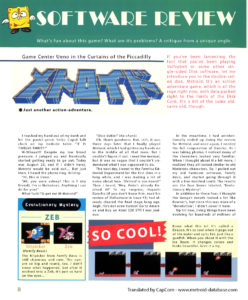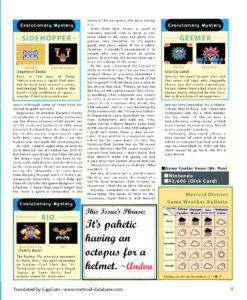As we celebrate the 35th anniversary of Metroid, I wanted to take a step back and review the game’s coverage in Japan’s premier gaming magazine, Famitsu. Today considered the gold standard for Japanese gaming news reporting and reviews, things appear to have been pretty clunky for the first few months, as the game’s review attests. The images above are a translated version, and the originals are available on Archive.org.
Metroid was reviewed in Issue No. 8 (October 3, 1986) by Toshiyuki Ueno (aka “Game Center Ueno”, ゲヱセン上野), a journalist as well as programmer, composer, and sound designer who later famously worked on Yuji Horii’s Hokkaido Rensa Satsujin: Okhotsk ni Kiyu. With a publication date nearly two months after Metroid’s release, this really demonstrates how slow Famitsu could be with releasing reviews in those early issues (Akumajo Dracula, for instance, wasn’t reviewed until November, despite a late September release). It’s also surprising Ueno not only had to purchase the game himself, but that he was trying to pick up a copy on August 26 (a Tuesday), a full 20 days after its release—and was afraid it would sell out. (Of course, he could have always opted to use a Disk Writer Kiosk…) In any case, at least some staff had to buy their own games rather than use review copies. Whether Ueno was reimbursed by Famitsu is another matter… Even so, he didn’t even get to play his copy for another full three days, August 29! Three weeks is an awful long time to start working on a review of the latest hot title, don’t you think??
At the time, Famitsu did not yet have its famous 40 points ratings system (this was first implemented in Issue No. 10, dated October 31, 1986). Instead they used a “weather forecast” that ranged from sunny, partly cloudy, cloudy, rainy, to snow for particularly bad cases. The grading criteria are also somewhat confusing:
- Clarity (明かるさ): how easy the game is to understand
- Appeal (大衆性): how much players will like it
- Impression (印象): the aesthetic feel of the game
- Depth (奥行き): how “big” the game is, how much content
- Overall (総合): a synthesis of the above scores
Thankfully, these symbols can be easily converted to a five-point ratings scale, and four raters for five categories gives a cumulative score out of 100. Under this system, Metroid received 18/25, 16/25, 15/25, and 20/25, for a total of 69/100—pretty dismal (about a 27/40). Ueno was the harshest with a 15/25, and it’s unfortunate his perspective was the only one published. Professional journalist Akihito Tomizawa (aka “Tomisawa Geinou”/”Tomisawa Entertainment”) liked it the most.
Ueno praised Metroid for the smoothness of the gameplay, particularly the Screw Attack (which was also featured heavily in official ads). All the reviewers thought highly of its depth, as the game has a pretty large map with a lot of meat behind it. Shockingly, however, the general consensus seems to be that Metroid was pretty derivative, with Ueno summarizing it as more of the “same old, same old” and “just another action adventure game.” Very surprising for what we consider today as a highly innovative design.
He also found Metroid to be unreasonably difficult—not in terms of hard gameplay, but in how it was so obtuse and confusing, with even the manual providing little help in figuring out what to do. This was particularly true of the difficulty of finding secret passages, which don’t have an easily recognizable silhouette like they do in later games (you know what spot in Norfair I’m talking about!). Ueno-san ultimately found it was far more difficult than locating bombable walls in The Legend of Zelda, and two other reviewers also rated Metroid “Rainy” for “Clarity”.
Oddly, Ueno was particularly harsh on the enemy designs, which he felt were recycled from earlier games like Famicom BASIC, Clu-Clu Land, and Mario Bros. And even though Metroid’s soundtrack is today considered a classic, he felt it didn’t hold a candle to the soundtrack of The Legend of Zelda (the review goes to great lengths to emphasize the Famicom Disk System has an FM sound source and the composers should “try a little harder”).
While there are some fair points (Metroid is by no means a polished gem), Ueno-san’s review doesn’t come across as particularly good writing or ultimately fair. The majority of the review is spent discussing how he got the game and how hard it was to play before devolving into a bizarre tangent about the Famicom’s FM sound chip (which makes more sense when you consider he later composed for it). Instead of going into detail on the controls or gameplay, he summarizes it rather bluntly as, “Yes, it’s rather fun, isn’t it?” It begins to give the impression Ueno didn’t even clear it. Clearly Ueno wasn’t the best person to review the game, and he even admits the assignment was basically dropped in his lap (“I had unintentionally ended up doing the review for Metroid…”). Not really an auspicious start to one of the defining franchises of videogames!
Incidentally, “This Issue’s Phrase” (“octopus helmet”) seems to refer to having a Metroid stuck on your head.
A special thanks to Hubz of Gaming Alexandria, who has collected and scanned dozens of copies of Famitsu and uploaded them to Archive.org. This is the first time Famitsu has been widely available to a Western audience, and I would like to thank Hubz and Gaming Alexandria for all of their hard work. It is this type of commitment that allows such research to be possible.
“Until next time…”
Captain Commando




